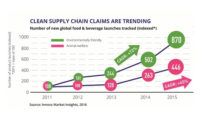Watch your ingredients list
• An undetermined amount of chili was recalled because the label read “lecithin” instead of “soy lecithin.”
• 131,000 pounds of pizza products were recalled because wheat was listed in the spice blend but not declared in the ingredient statement of the finished product label.
• 216,000 pounds of Portobello-flavored pork loin containing whey was recalled after the company reformulated the product. During an internal label review, the company discovered that the label of the Portobello spice being utilized did not match the ingredient list of the final product.
• 285,000 pounds of barbecue products containing soy were recalled, also after the product was reformulated.
• 18,000 pounds of chicken products that contained fish, in the form of an anchovy puree in Worcestershire sauce, were recalled. The company had changed ingredient suppliers.
No allergic reactions or illnesses were reported in any of the recalls. All those hundreds of thousands of pounds of products could have been safety consumed if the labeling had been correct.
If there's a lesson for the meat industry, it's that labeling deserves just as much attention to detail as actually manufacturing the product. Companies need to be aware of how a change in formulation will affect not only the taste of the item but also the label requirements. Any changes to the labeling, even if it's a cosmetic change, require a thorough proofreading of the ingredients list to make sure a key element hasn't been left off.
There also must be constant communication with ingredient suppliers. Any change to the spice blend, on the part of the supplier or the processor, has to be carefully considered. Likewise, a change in ingredient suppliers requires both companies to work together closely to ensure a smooth and painless transition.
Food companies consider the food-safety aspects of packaging all the time, but what the package says (or doesn't say) is too important to ignore. IP
Looking for a reprint of this article?
From high-res PDFs to custom plaques, order your copy today!







